War without boots
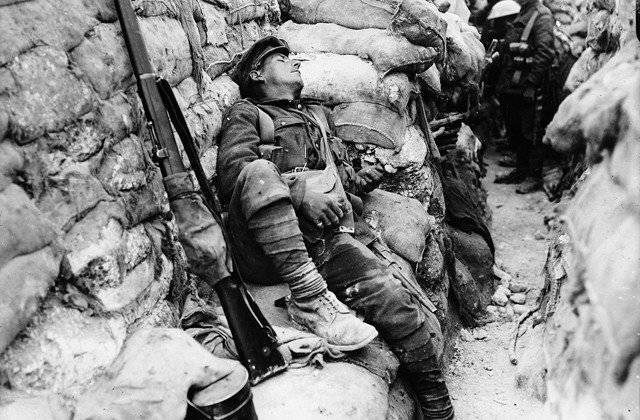
What are windings and why did the Russian army change its shoes on the roads of the Great War?
"The boot of the Russian soldier" - for centuries of domestic stories This expression has become almost an idiom. At different times, these boots trampled the streets of Paris, Berlin, Beijing and many other capitals. But for the First World War, the words about the “soldier's boot” became an obvious exaggeration - in 1915-1917. most of the soldiers of the Russian Imperial Army did not wear boots anymore.
Even those who are far from military history, according to old photographs and newsreel frames - and not only the First World War, but also the Great Patriotic War - are remembered for the 21st century outlandish “bandages” of soldiers on their feet. More advanced ones remember that such “bandages” are called windings. But few people know how and why this strange and long-disappeared subject of army shoes appeared. And almost no one knows how they were worn and why they were needed.
1908 model boot of the year
In World War I, the Russian Empire army marched in the so-called “boots for the lower ranks of the 1908 model of the year”. Its standard was approved by the General Staff Circular No. 103 of 6 May 1909. In fact, this document approved the type and cut of the soldier's boot, which existed throughout the XX century and today, the second century is still in the “armament” of the Russian army.
Only if in the Great Patriotic War, the Afghan or Chechen wars, this boot was made mainly of artificial leather, “kersey”, then at the time of its birth it was made entirely of soft leather or Russian leather. On the eve of the First World War, chemical science and industry have not yet created synthetic materials, of which a significant portion of current clothing and footwear is made.
The term “yalovy”, which came from distant antiquity, in Slavic languages meant not giving or not yet giving offspring of animals. "Yalovaya skin" for soldiers' boots was made from the skins of one-year-old gobies or non-breeding cows. This skin was optimal for durable and comfortable shoes. Older or young animals were not suitable - the delicate skin of calves was still not strong enough, and the thick skins of old cows and bulls, on the contrary, are too tough.
Well processed - seal lard (blubber) and birch tar - a kind of “raw skin” was called “yuft”. It is curious that this medieval Russian word has passed into all major European languages. French youfte, english yuft, dutch. jucht, German juchten originate from the Russian term "yuft", borrowed from the Eastern Slavic tribes, in turn, from the ancient Bulgars. In Europe, “yuft” was often called simply “Russian leather” - since the times of the Novgorod Republic, it was Russian lands that were the main exporters of tanned leather.
By the beginning of the 20th century, the Russian Empire, despite all the successes of industrial development, remained primarily an agricultural country. According to 1913 statistics of the year, 52 million cattle were grazed in the vastness of the empire and about 9 million calves were born annually. This made it possible to fully supply all the soldiers and officers of the Russian army with leather boots, which on the eve of the Great War in peacetime numbered 1 million 423 thousand people.
The leather boot of a Russian soldier, model 1908, had an ankle height of 10 inches (about 45 centimeters), counting from the top edge of the heel. For the Guards regiments, the tops were longer on 1 tips (4,45 cm).
The upper was sewn with one seam at the back. It was a new design for that time - the old soldier's boot was sewn more on the model of the boots of the Russian Middle Ages and was noticeably different from the modern one. For example, the tops of such a boot were thinner, sewn together with two seams on the sides, and gathered around the leg of the leg into an accordion. Such boots, reminiscent of the shoes of the archers of the pre-Peter era, were popular with wealthy peasants and artisans in Russia at the turn of the XIX-XX centuries.
The soldier's boot of the new model, while respecting all the technologies, was a little more durable than the previous one. It is no coincidence that this design, replacing only the materials with more modern ones, has been preserved practically to the present day.
The General Staff Circular No. 103 from 6 May 1909 strictly regulated the manufacture and all materials of the soldier's boot, up to the weight of leather insoles - “at 13% humidity” depending on the size they had to weigh from 5 to 11 spools (from 21,33 to 46,93 gr .). The leather sole of a soldier's boot was fastened with two rows of wooden studs - their length, location and method of fastening were also regulated in paragraphs Circular No. XXUMX.
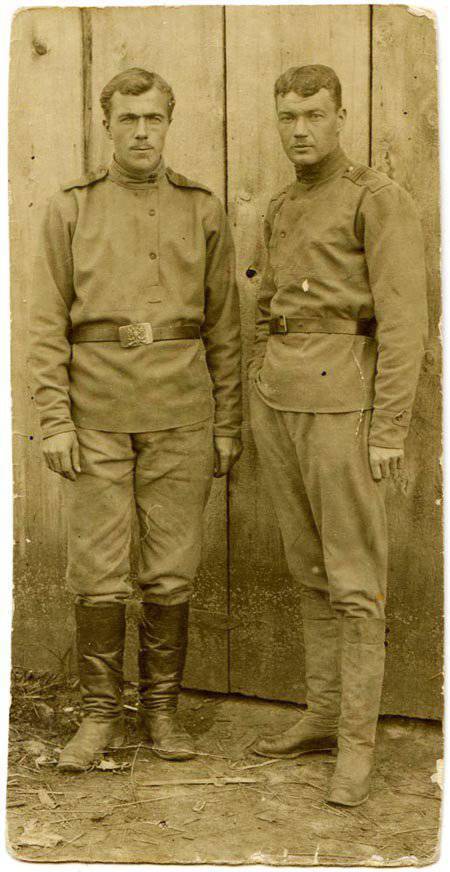
The heel was straight, height 2 cm, it was fastened with iron studs - from 50 to 65 pieces - depending on the size. In total, 10 sizes of soldiers' boots were installed along the length of the foot and three sizes (A, B, C) in width. It is curious that the smallest size of the 1908 model soldier's boot of the year corresponded to the modern size of the 42 - the boots were worn not on a thin sock, but on a footcloth that almost disappeared from our everyday life.
In peacetime, for the year, a pair of boots and three pairs of footcloths were given out to the ordinary. Since the shoe wears primarily the soles and soles, they were supposed to have two sets for a year, and the tops were changed only once a year.
In the warm season, the soldiers' footcloths were “canvas” - from linen or hemp canvas, and from September to February the soldier was given out “cloth” - from wool or wool blend.
Half a million shoe polish
Wholesale for the purchase of leather raw materials and sewing one pair of soldier's boots on the eve of 1914, the royal treasury spent 1 ruble 15 kopecks. According to the statute, the boots had to be black, in addition, natural shoe leather with intensive use required regular lubrication. Therefore, the treasury allocated 10 kopecks for blacking and initial lubrication of the boots. Total at wholesale price soldier boots cost the Russian Empire in the amount of 1 ruble 25 kopecks a pair - about 2 times cheaper than the cost of a pair of simple leather boots in retail on the market.
The officer's boots were almost 10 times more expensive than the soldiers, differing in both style and material. They were sewed individually, usually from more expensive and high-quality goat "chromic" (that is, in a special way dressed) skin. Such “chrome boots”, in fact, were the development of the “morocco boots”, famous in the Russian Middle Ages. On the eve of 1914, simple officer "chrome" boots cost 10 rubles for a couple, formal dresses - about 20 rubles.
Leather boots were then treated with wax or shoe polish - a mixture of soot, wax, vegetable and animal oils and fats. For example, every soldier and noncommissioned officer in a year was entitled 20 kopecks "for lubrication and blackening of boots." Therefore, the Russian Empire spent almost 500 thousand rubles annually only on lubricating the boots of the “lower ranks” of the army.
It is curious that, according to the General Staff Circular No. 51 from 1905, Vax was recommended for lubrication of army boots. It was produced in Russia at the factories of the German company Friedrich Baer - it is a chemical and pharmaceutical company and is now well known by the Bayer AG logo. Recall that before 1914, almost all chemical plants and factories in the Russian Empire belonged to German capital.
All in all, on the eve of the war, the royal treasury spent about 3 million rubles annually on soldiers' boots. For comparison, the budget of the entire Ministry of Foreign Affairs was only 4 times larger.
“They will discuss the situation in the country and demand a constitution”
Up to the middle of the 20th century, any war was a matter of the armies, moving mainly on their own two feet. The art of marching was the most important component of victory. And, of course, the main burden fell on the feet of the soldiers.
Even now, war shoes are one of the most consumable items along with weapons, ammunition and human lives. Even when a soldier does not participate in battles, in various jobs and simply in the field, he primarily “spends” shoes.
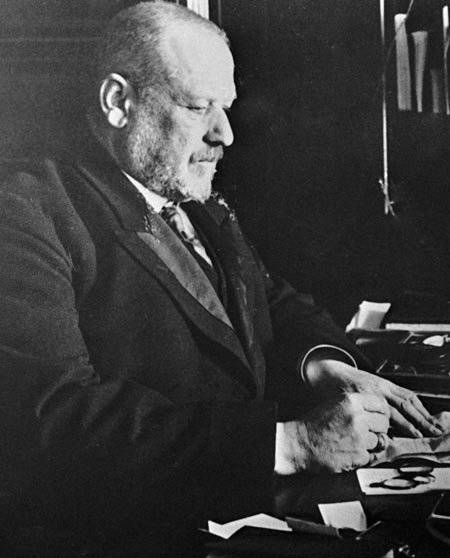
The issue of supplying shoes was particularly acute in the epoch of the appearance of massive draft armies. Already in the Russo-Japanese war 1904-05, when Russia, for the first time in its history, concentrated on one of the distant fronts of half a million soldiers, the army quartermaster suspected that if the war was delayed, the army was threatened with a shortage of boots. Therefore, on the eve of 1914, the men in the 1,5 warehouses gathered a million pairs of new boots. Together with 3 million pairs of boots stored and used directly in the army units, this gave an impressive figure that calmed the command. At that time, no one in the world thought that a future war would drag on for years and overthrow all calculations for the consumption of ammunition, weapons, human lives and boots, in particular.
By the end of August, 1914 million 3 thousand "lower ranks" were called up by 115 million in Russia from the reserve, and 2 million people were mobilized by the end of the year. Those who went to the front were supposed to have two pairs of boots - one directly on the legs and the second spare. As a result, by the end of 1914, stocks of boots had dried up not only in warehouses, but also in the domestic market of the country. According to the forecasts of the command, in the new conditions on the 1915 year, taking into account losses and expenses, at least 10 million pairs of boots were required, which were nowhere to take.
Before the war, footwear industry in Russia was exclusively engaged in the handicraft industry, thousands of small handicraft factories and individual shoemakers scattered throughout the country. In peacetime, they coped with army orders, but there was no system for mobilizing shoemakers to carry out huge new army orders in wartime conditions, even in designs.
Major General Alexander Lukomsky, head of the mobilization department of the General Staff of the Russian Army, later recalled these problems: “The impossibility of satisfying the needs of the army with domestic industry was somehow unexpected for everyone, not excluding the quartermaster's office. It turned out to be a lack of leather, a lack of tannins for their manufacture, a lack of workshops, and a shortage of working hands of shoemakers. But it all came from the lack of proper organization. There were not enough leathers on the market, and hundreds of thousands of leathers that were removed from livestock eaten for the army were rotting at the front ... Plants for the preparation of tannins, if they had thought about it in time, would have been easy to arrange; in any case, it was not difficult to get ready tannins from abroad in time. There were also enough working hands, but again, we didn’t think about the proper organization and development of workshops and artisanal cooperatives. ”
They tried to attract the “zemstvo” to the problem, that is, the local government, which worked throughout the country and theoretically could have organized co-workers' co-operation on the scale of all of Russia. But here, as one of his contemporaries wrote, “no matter how strange it may seem at first glance, even politics was mixed with the issue of supplying the army with boots.”
Chairman of the State Duma, Mikhail Rodzianko, in his memoirs described his visit to the headquarters of the Russian army at the end of 1914 at the invitation of the Supreme Commander, who then was the uncle of the last tsar, Grand Duke Nikolai Nikolayevich: “The Grand Duke said that he was forced to stop military operations by the absence of shells and the lack of boots in the army. "
The commander-in-chief asked the chairman of the State Duma to work with the local government to organize the production of boots and other footwear for the army. Understanding the scale of the problem, Rodzianko reasonably proposed to gather in Petrograd an all-Russian convention of zemstvos to discuss it. But then Maklakov, the Minister of the Interior, spoke out against him, saying: “According to intelligence, under the guise of a congress for the needs of the army, they will discuss the political situation in the country and demand a constitution.”
As a result, the Council of Ministers decided not to convene any congresses of local authorities, and to entrust the work with the zemstvos for the production of boots to entrust the chief quartermaster of the Russian army, Dmitry Shuvaev, although he, as an experienced business executive, immediately declared that the military authorities had never “done business with zemstvos "And therefore will not be able to quickly organize the overall work.
As a result, work on the production of shoes for a long time was haphazardly, an unregulated market for massive purchases of leather and boots responded with a deficit and rising prices. For the first year of the war, the prices for boots increased 4 times - if in summer 1914, simple officer boots in the capital could be sewn for 10 rubles, then a year later their price had already exceeded 40, although inflation was still minimal.
"Almost the entire population went to the soldiers' boots"
The problems were aggravated by complete mismanagement, since for a long time the skins of cattle slaughtered for the army were not used. The refrigeration and canning industries were only in their infancy, and tens of thousands of animals were driven by huge herds right to the front. Their skins would give enough raw materials for the production of shoes, but usually they were just thrown away.
Do not take care of the boots and the soldiers themselves. Two pairs of boots were given to each mobilized, and often soldiers sold or changed them on the way to the front. Later, General Brusilov wrote in his memoirs: “Almost the entire population wore soldier's boots, and most of the people who arrived at the front sold their boots along the way to the philistines, often for nothing and received new ones at the front. Some craftsmen managed to do this monetary operation two or three times. ”
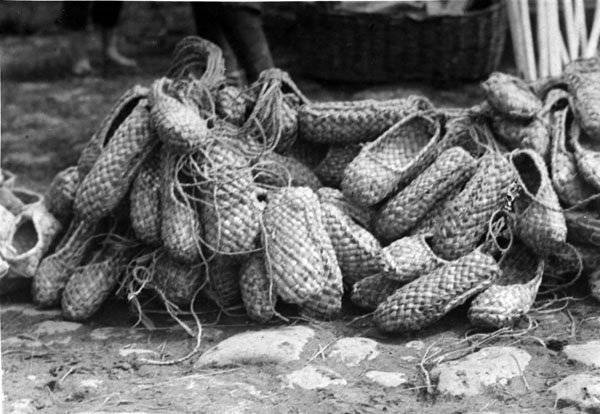
The general has thickened colors a little, but rough calculations show that, indeed, about 10% of state-owned army boots during the war years were not at the front, but on the domestic market. The army command tried to fight it. Thus, 14 February 1916 of the year on the VIII th Army of the Southwestern Front issued an order: "The lower ranks, squandering things on the way, as well as those who arrived at the stage in tattered boots, arrest and prosecute, subject to pre-punishment with rods." Penalty soldiers usually received 50 strikes. But all these completely medieval measures did not solve the problem.
The first attempts to organize a massive tailoring of boots in the rear turned around no less. In some counties, local police officers, having received the order of the governors to bring shoemakers from areas not engaged in army work, to the Zemsky and military workshops, resolved the issue simply - ordered to collect all shoemakers in the villages and, as arrested, deliver them to the county towns . In a number of places, this turned into riots and fights of the population with the police.
In some military districts a requisition of boots and shoe material was carried out. Also, all shoemakers were forced to make at least two pairs of boots a week for the army for a fee. But in the end, according to the Ministry of War, for 1915 a year, troops received only 64,7% of the required number of boots. A third of the army turned out to be loose.
Army in sandals
Lieutenant-General Nikolai Golovin described the situation with shoes when he was Chief of Staff VII of the Army on the South-Western Front in the fall of 1915, in Galicia: “After disembarking from the railway, parts of this army had to go through 4 – 5 transitions to occupy front of the place. This marching movement coincided with the autumn thaw, and the infantry lost their boots. Here our sufferings began. Despite the most desperate requests for the expulsion of boots, we received them in such insignificant portions that the army’s infantry went barefoot. Such a catastrophic situation lasted almost two months. ”
We note the indication in these words not only about the shortage, but also about the poor quality of army boots. Already in emigration in Paris, General Golovin recalled: "There was no need to worry about such an acute crisis as in the supply of shoes, in other types of supplies."
In 1916, the commander of the Kazan Military District, General Sandetsky, reported to Petrograd that 32 240 soldiers of the district's reserve battalions to be sent to the front do not have shoes, and since they are not available in warehouses, they must replenish the district in shoes they bought in villages. bast shoes.
The letters of the soldiers of the First World War tell about the glaring problems with shoes on the front. In one of these letters, preserved in the archives of the city of Vyatka, you can read: “They don't shoe us in boots, but give out shoes, and issue infantry sandals”; “We walk halfway in sandals, the German and the Austrian laugh at us — they take captive someone in sandals, they will remove their sandals and hang them out on the trench and shout — do not shoot their sandals”; "Soldiers sit without boots, legs wrapped with bags"; “They brought two bast wagons, until such a shame — an army in bast shoes — up to what they had fought ...”
Trying to somehow deal with the "shoe" crisis, the 13 command of the imperial army had already allowed 1915 on January 2 to sew boots for soldiers with X-shirts shortened on 9 (almost XNUMX cm), and then followed an order to issue soldiers with leather boots instead of the statues, boots with windings and "canvas boots", that is, boots with tarpaulin tops.
Before the war, the rank and file of the Russian army was supposed to always wear boots, but now they were allowed to give out any other available shoes for work "outside the ranks". In many parts, finally, they began to use the skins of the cattle-stuffed day of making leather bast shoes.
With such shoes, our soldiers first met during the Russian-Turkish war 1877-78. In Bulgaria. The Bulgarians called leather “sandals”, and that is how they were named, for example, in the order for the 48-th Infantry Division from December 28 of the 1914 of the year. At the beginning of the war, this division from the Volga region was transferred to Galicia, and after a few months, when faced with a shortage of boots, she was forced to make opanks for the soldiers.
In other parts, the similar footwear was called in the Caucasian manner “Kalamans” or in Siberian - “cats” (emphasis on “o”), as women’s half boots were called outside the Urals. In 1915, such homemade leather sandals were already spread all over the front.
Also, the soldiers wove for themselves the usual bast from luka, and in the rear parts they made and wore boots on a wooden sole. Soon the army even began a centralized purchase of bast shoes. For example, in 1916 from the city of Bugulma of the Simbirsk province, the zemstvo put 24 thousand pairs of bast shoes into the army for 13 740 rubles. - each pair of sandals cost the army treasury 57 kopecks.
Realizing that they could not cope with the shortage of army shoes on their own, the tsarist government already in 1915 year turned to the Allies for boots in boots. In the autumn of that year, the Russian military mission of Admiral Alexander Rusin sailed from Arkhangelsk to London with the aim of placing Russian military orders in France and England. One of the first, besides requests for rifles, was a request to sell 3 million pairs of boots and 3600 pounds of plantar skin.
Boots and shoes in 1915, regardless of costs, tried to urgently buy around the world. For soldiers' needs, they tried to adapt even a batch of rubber boots purchased in the US, but for hygienic properties they were still refused.
“In 1915, it was already necessary to make very large orders for shoes, mainly in England and in America,” later recalled General Lukomsky, head of the mobilization department of the Russian General Staff. - These orders cost the treasury very expensive; there were cases of extremely unfair performance, and they took a very significant percentage of the tonnage of ships, so precious for the transportation of military supplies. "
German Knobelbecher and English Puttee
Difficulties with shoes, though not on such a scale, were experienced by almost all the allies and opponents of Russia in the Great War.
Of all the countries that entered the massacre in 1914, only the armies of Russia and Germany were fully shod in leather boots. The soldiers of the “Second Reich” started the war in the boots of the 1866 model of the year, introduced by the army of Prussia. Like the Russians, the Germans then preferred to wear a soldier’s boots not with socks, but with footcloths - Fußlappen in German. But, unlike the Russians, the German soldier’s boot had 5 tops, shorter, which were sewn together with two seams on the sides. If all Russian boots were necessarily black, then in the German army some units wore brown boots.
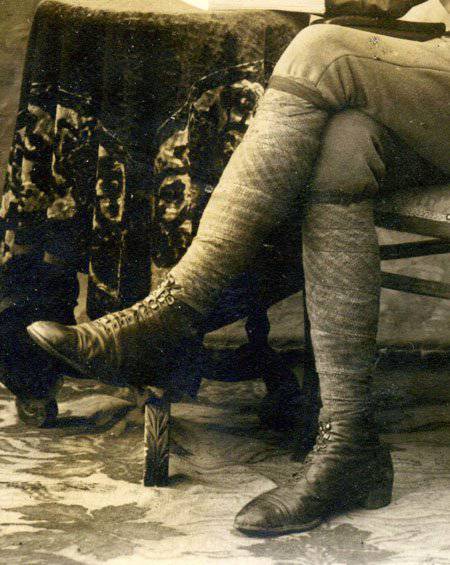
The sole was reinforced with 35-45 iron nails with wide caps and metal shoes on the heel - thus, metal covered almost the entire surface of the sole, which gave it durability and a distinctive clang when columns of German soldiers walked along the pavement. The mass of metal on the sole retained it during marches, but in winter this iron froze and could chill the legs.
The skin was also somewhat tougher than that of Russian boots, it was no coincidence that German soldiers jokingly nicknamed their official shoe Knobelbecher - “a glass for dice”. The soldier's humor meant that the foot was loose in a strong boot, like bones in a glass.
As a result, a lower and tough German soldier's boot was a little stronger than the Russian: if in peacetime in Russia a pair of boots relied on a soldier for a year, then in economical Germany - for a year and a half. In the cold, the savvy mass of metal boots was more inconvenient than the Russian, but when it was created, the General Staff of the Kingdom of Prussia planned to fight only against France or Austria, where there are no 20-degree frosts.
The French infantry began the war not only in blue coats and red trousers noticeable from afar, but also in very curious shoes. The Third Republic infantryman wore leather shoes of the “1912 model of the year” - in the form of exactly modern fashionable men's shoes, only the entire sole was riveted with 88 iron nails with a wide hat.
From the ankle to the middle of the calf, the leg of the French soldier was protected by patch leather “leggings of the 1913 design of the year”, fixed with a leather cord. The outbreak of war quickly showed the shortcomings of such shoes - the army shoe of the “1912 model of the year” had an unsuccessful cut in the lacing area that easily let in water, and the “leggings” not only spent their expensive skin during war, but they were uncomfortable to wear and rub their calves while walking .
It is curious that Austria-Hungary began the war simply in boots, abandoning boots, short leather Halbsteifel, in which the soldiers of the “two-sided monarchy” fought for the entire XIX century. The trousers of the Austrian soldiers were tapered to the bottom and buttons were fastened at the boot. But this decision was not convenient either - the foot in a low boot was easily wetted, and not protected trousers in the field quickly torn to shreds.
As a result, by the year 1916 most of the soldiers of all the countries involved in the war wore optimal military footwear for those conditions - leather shoes with cloth windings. It was in such shoes that the army of the British Empire entered the war in August 1914.
The rich "factory of the world", as England was then called, could afford to dress the whole army with boots, but its soldiers also had to fight in Sudan, South Africa and India. And in the heat in leather boots you don’t seem like it, and practical British people adapted for their needs an element of the highlander shoes in the Himalayas - they tightly wrapped a long narrow piece of fabric from ankle to knee.
In Sanskrit, it was called "patta", that is, tape. Shortly after the suppression of the CPE uprising, these "tapes" were adopted in the uniform of the soldiers of the "British Indian Army". By the beginning of the 20th century, the entire army of the British Empire wore windings in field conditions, and the word “puttee” was translated into English from Hindi, by which these “tapes” were designated.
Secrets of winding and leather lace
It is curious that at the beginning of the 20th century, the windings were also a common element of clothing of European athletes in the winter time - runners, skiers, and skaters. Often used them and hunters. Elastic synthetics did not exist then, and the dense fabric “bandage” around the leg not only fixed and protected it, but also had a number of advantages over the skin.
Winding is easier than any leather gaiters and tops, the leg under it “breathes” better, therefore, it is less tired, and, most importantly in war, it reliably protects the foot from dust, dirt or snow. Crawling on their bellies, the soldiers in their boots will, in one way or another, scoop them with their tops, but the windings will not. At the same time, a leg wrapped in several layers of fabric is also well protected from moisture - walking through dew, wet soil or snow does not lead to getting wet through.
In mudslides, in the field or in trenches filled with water, the boots got stuck in the mud and crawled, but the boot with a well-tied winding held tight. In the heat, the legs in the windings do not disappear, unlike the legs in the boot, and in cold weather an additional layer of fabric warms well.
But the main thing for a big war turned out to be a different property of the windings - their amazing cheapness and simplicity. That is why, by 1916, the soldiers of all the belligerent countries fought, mainly in the windings.
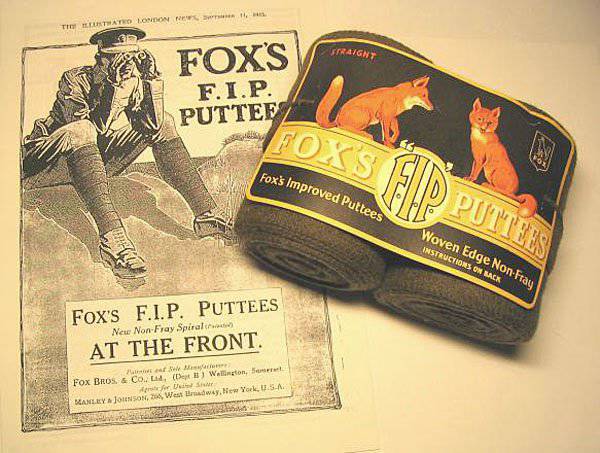
The production of this simple object then reached fantastic volumes. For example, only one British company Fox Brothers & Co Ltd during the First World War produced 12 million pairs of windings, in the unfolded state it is a tape 66 thousand km long - enough to wrap the entire coast of Great Britain twice.
Despite all the simplicity, the windings had their own characteristics and required skills to wear them. There were several varieties of windings. The most common were the windings, fixed with ties, but there were also varieties, fastened with small hooks and buckles.
In the Russian army, the simplest windings on strings with a length of 2,5 m and a width of 10 were usually used. In the “removed” position they were rolled up into a roll, with the laces turned out to be inside, being a kind of “axis”. Taking such a roll, the soldier began to wind the winding on the leg from the bottom up. The first turns should be the most tight, carefully closing the upper part of the boot in front and behind. Then the tape was bandaged on the leg, the last turns did not reach the knee a little. The end of the winding was usually a triangle, at the top of which two laces were stitched. These laces were wrapped around the last turn and tied, the resulting bow was hidden behind the upper edge of the winding.
As a result, the wearing of the windings required a certain skill, as well as the comfortable wearing of the footcloths. In the German army, the cloth winding of a long 180 cm and 12 cm wide crocheted hooked onto the edge of the boot and wound tightly from bottom to top, fixing itself under the knee with ties or a special buckle. The English had the most difficult method of tying the winding - first from the middle of the shin, then down, then up again.
By the way, the way of tying army boots during the First World War was markedly different from the modern one. Firstly, the leather cord was most often used at that time — there was still no synthetic material, and the cloth wore out quickly. Secondly, he was usually not tied to knots or bows. The so-called “lacing with one end” was used - a knot was tied at the end of the lace, the lace was threaded into the bottom opening of the lacing so that the knot was inside the skin of the shoe, and the other end of the lace was sequentially passed through all the holes.
In this way, the soldier, wearing a shoe, in one motion tightened the entire lacing, wrapped the end of the lace around the top of the shoe and simply tucked it over the edge or lacing. Due to the stiffness and friction of the leather lace, such a “design” was securely fixed, allowing you to dress and tie the shoe in just a second.
"Cloth protective bandages on the legs"
In Russia, the windings in service appeared in the spring of 1915. At first, they were called "cloth protective bandages on the shins," and the command planned to use them only in summer, returning from autumn to spring thaw to their old boots. But the lack of boots and the increase in skin prices forced the use of windings at any time of the year.
Boots to the windings used a variety of, from a good leather, a sample of which was approved by the command of 23 February 1916, to various handicrafts workshops. For example, 2 March 1916, the order of the command of the South-Western Front №330 began manufacturing a soldier canvas canvas shoe with a wooden sole and a wooden heel.
It is indicative that the Russian Empire was forced to purchase not only complex weapons like machine guns and aircraft engines in the West, but also such primitive things as windings - by the beginning of 1917, in England, along with brown shoes, they bought such a large batch of woolen mustard-colored windings that they were widely used in the infantry all the years of civil war.
It was shoes with windings and gigantic purchases of shoes abroad that allowed the Russian army to 1917 a little to alleviate the “shoemaker” crisis. Only in a year and a half of the war, from January 1916 of the year to 1 of July 1917, the army took 6 million 310 thousand pairs of boots, of which 5 million 800 thousand were ordered abroad. For 1916, the army and rear warehouses arrived before 29 million pairs of shoes (of which only about 5 million pairs of boots), and for all the years of the Great War in Russia, among other things, 65 million pairs of leather and canvas canvas boots and shoes were sent to the front.
At the same time, throughout the entire war, the Russian Empire called for "under the gun" over 15 million people. According to statistics, during the year of fighting 2,5 pairs of shoes were spent on one military, and only in 1917 a year the army wore out almost 30 million pairs of shoes - until the very end of the war the shoe crisis was not finally overcome.
Information